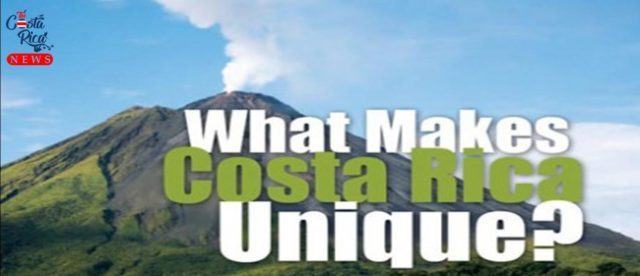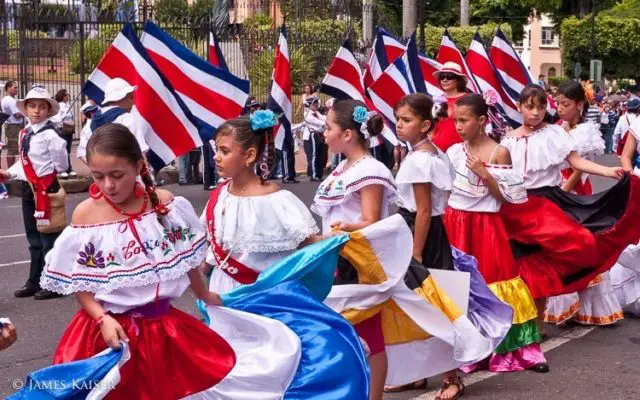
The Costa Rican folk tradition has diverse cultural manifestations that include music, dance, legends, traditions, songs, popular proverbs, tales, sayings, romances, riddles, which are common and recognizable by the majority of the population of the country and which are generally used during popular and patron festivities, and vary according to each region and town.
The majority of Costa Rican folk music rhythms are combined with other cultural expressions, such as dance, traditional dress, and musical instruments. This music and its rhythms are usually associated with civic, religious and popular holidays. It is produced in four specific areas of the country: Guanacaste, the Central Valley, Limón and Puntarenas, however, each province has its idiosyncrasy, and Afro-Caribbean and Amerindian music is present in the various areas and complements the national culture
Legends of Costa Rica
Part of the Costa Rican idiosyncrasy, are the legends of the deceased, spirits and miracles of real or invented characters that the people of yesteryear recreated in extraordinary situations, whether to leave teaching to the listener, almost always children or to exaggerate reality.
The legends are not simply part of the cultural heritage, but this is a culture in itself because they feed on the traditions and wonderful facts of a nation.
Some of these Tico legends are:
• The witch of Escazú, the “Black Mary”
• The Ghost Cart
• The Cart without Oxen
• The Cegua
• The Legend of the Zurquí
• The Llorona
• The Tulevieja
• The Yegüita
• The Zegua of Poás.
Hymns and songs
Among the beautiful hymns and traditional songs of the people of Costa Rica are:
Hymn to the Annexation of Guanacaste
Patriotic Anthem to Juan Santamaría
National Anthem of Costa Rica
Hymn to the Flag of Costa Rica
Patriotic Anthem to September 15.
The Typical “Bombas” of Costa Rican folklore
“Bombas” are examples of oral expressions, mostly quartets, that express aspects of everyday life, especially Guanacaste and we can classify them into:
• Amusing
• Loving or romantic.
• Picaresque.
• Bold.
• Challenges.
• Despising.
The “Bombas” is an important cultural and didactic form, at the same time in its content it is possible to give motivation and much joy. These are part of our folklore and that enliven feelings of a past that will not return and allow us to recover part of our identity.
The “Bombas” are both of Guanacaste and the Central Plateau origin. A collection of this material is made to disseminate and study the literary forms of the “Sabanero” and the “Meseteño” use. When they improvise, these rhymed couplets are the product of their inspiration; or of the woman who also knows how to answer them with the original taste, grace and charm of her own and that characterizes our cultural heritage.
Here’s an example:
“¡Bomba!
Ey… Ey… Ey…
Soy puro tibaseño,
soy como el “venao”
me resbalo en lo seco
y me paro en lo “mojao”
uyuyuy carajo…”
“¡Bomba!
El bejuco cuando nace
nace hojita por hojita
así comienza el amor …
palabra por palabrita.
uyuyuy mamita …”
Typical Costa Rican Dances
El Punto
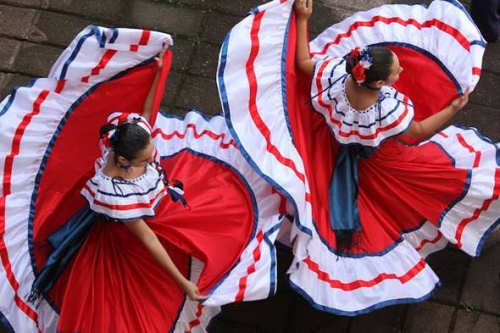
The “Punto Guanacasteco” was born in the 1830s and its cradle was the very heart of this town. Over a hundred years running through the veins and musical taste of our ancestors throughout Guanacaste and the rest of the country. This “Parrandera” rhythm is an authentic Costa Rican rhythm born in our province. In the musical field, it is the particular seal that unites and identifies us.
The Tambito
It has an unknown origin. It is believed to descend from the ancient Spanish dance. Currently, in the Guanacaste territory, the piece called “El Zapateado” is played in the form of a drum. This dance was called in the last century “El Zapateado de Cádiz”, which suggests that it has a Spanish influence. The rhythm of “Tambito is ¾”.
The Cajeta
Another popular dance, called “La Cajeta”, is in honor of a dessert, made of fudge and milk. The cuisine of this dessert has a lot of work in its preparation, which is only done in large quantities. People use this as an excuse to have a party. In the haciendas, the available men come in search of a woman with the potential to be their wives. The dance represents the illusion of romance.
The Yegüita
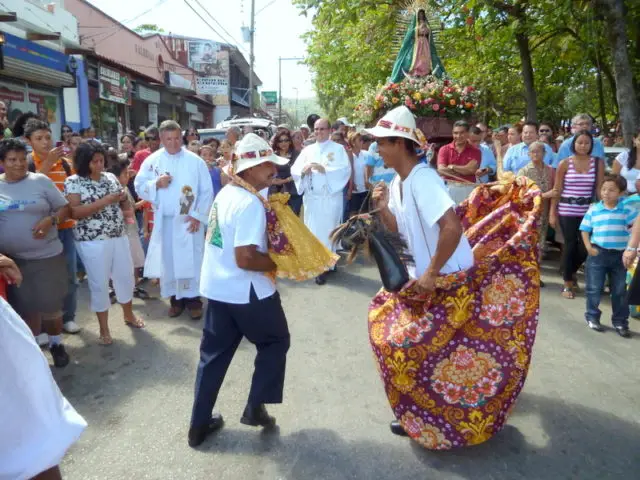
This folk dance represents an ancient tradition of men wearing a horse costume (as a religious tradition). The “Yeguita” is performed on December 11th and 12th at 7 in the morning simulating taking a shower in front of the Virgin of Guadalupe (to the sounds of drums and whistles).
Chingo Devil
More than a dance, it is a theatrical representation of a popular legend. The main character is a bull with a short tail, which they call “Diablo Chingo”. According to the legend in Guanacaste, this short-tailed bull was frightening at night, hiding in the dark because the bull was black;
It skillfully cornered the people who passed through one of the streets of the town, making its inhabitants believe that it was the devil in the form of a bull. As there were many victims, all the neighbors decided to discover the enigma and went in search, finding it, they fought it all night until the animal fell exhausted. Without a doubt, this descriptive dance is inspired by the “Fiesta Brava” (bullfight), a cultural element of great tradition in the region and introduced by the Spaniards.
Traditional costumes
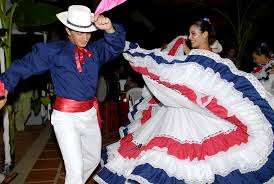
Typical costumes represent one of the most important elements of Costa Rica’s historical and cultural heritage. Each region and province of the country has its dress or work garments, with folklore and history behind it.
At present, the typical costumes are a fundamental part of the civic and folkloric activities of each town in the country. They are used in commemorative events, national holidays and cultural events.
In the traditional costume, the national colors dedicated to the national flag predominate, which are mainly used in civic activities such as the celebrations of Independence, the Annexation of the Nicoya Party or April 11th. There are also costumes dedicated to Costa Rican legends, the national flower, local traditions, music, and dances of each town, folk festivals and others.
Popular expressions
The expressions that the people use repeatedly and daily come to be a declaration of principles of a nation, which reflects their world view, environment, and mood, as a kind of mantra, whose meaning is filtered in the subconscious of the population that constantly repeats and is reflected in the characterization of culture and social dynamics allowing a unique idiosyncrasy.
The most entrenched expressions among the Ticos, that make them natives and foreign visitors recognize them through, among other situations, in the tenacious struggle of fruitful labor.
Pure Life
“Pura Vida” is the most recognizable phrase linked to Costa Ricans and that reflects the way of life of Costa Rica. Often when people walk in the streets or stores they say “pure life”. It can be given as a question or as an acknowledgment of your presence or be used as much as a greeting or farewell.
Ticos
“Tico” is a colloquial gentile synonymous with “Costa Rican”, which nationals use as self-confirmation of simplicity, peace, and industriousness.
